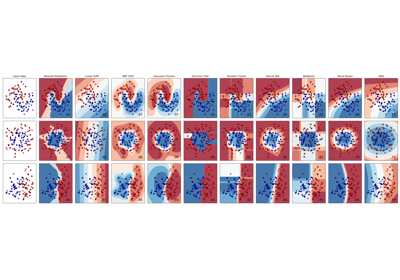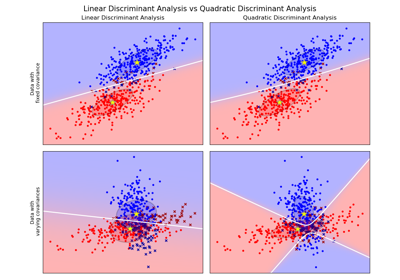sklearn.discriminant_analysis.QuadraticDiscriminantAnalysis¶
-
class
sklearn.discriminant_analysis.QuadraticDiscriminantAnalysis(priors=None, reg_param=0.0, store_covariance=False, tol=0.0001)[source]¶ Quadratic Discriminant Analysis
A classifier with a quadratic decision boundary, generated by fitting class conditional densities to the data and using Bayes’ rule.
The model fits a Gaussian density to each class.
New in version 0.17: QuadraticDiscriminantAnalysis
Read more in the User Guide.
- Parameters
- priorsarray, optional, shape = [n_classes]
Priors on classes
- reg_paramfloat, optional
Regularizes the covariance estimate as
(1-reg_param)*Sigma + reg_param*np.eye(n_features)- store_covarianceboolean
If True the covariance matrices are computed and stored in the
self.covariance_attribute.New in version 0.17.
- tolfloat, optional, default 1.0e-4
Threshold used for rank estimation.
New in version 0.17.
- Attributes
- covariance_list of array-like of shape (n_features, n_features)
Covariance matrices of each class.
- means_array-like of shape (n_classes, n_features)
Class means.
- priors_array-like of shape (n_classes)
Class priors (sum to 1).
- rotations_list of arrays
For each class k an array of shape [n_features, n_k], with
n_k = min(n_features, number of elements in class k)It is the rotation of the Gaussian distribution, i.e. its principal axis.- scalings_list of arrays
For each class k an array of shape [n_k]. It contains the scaling of the Gaussian distributions along its principal axes, i.e. the variance in the rotated coordinate system.
- classes_array-like, shape (n_classes,)
Unique class labels.
See also
sklearn.discriminant_analysis.LinearDiscriminantAnalysisLinear Discriminant Analysis
Examples
>>> from sklearn.discriminant_analysis import QuadraticDiscriminantAnalysis >>> import numpy as np >>> X = np.array([[-1, -1], [-2, -1], [-3, -2], [1, 1], [2, 1], [3, 2]]) >>> y = np.array([1, 1, 1, 2, 2, 2]) >>> clf = QuadraticDiscriminantAnalysis() >>> clf.fit(X, y) QuadraticDiscriminantAnalysis() >>> print(clf.predict([[-0.8, -1]])) [1]
Methods
decision_function(self, X)Apply decision function to an array of samples.
fit(self, X, y)Fit the model according to the given training data and parameters.
get_params(self[, deep])Get parameters for this estimator.
predict(self, X)Perform classification on an array of test vectors X.
predict_log_proba(self, X)Return posterior probabilities of classification.
predict_proba(self, X)Return posterior probabilities of classification.
score(self, X, y[, sample_weight])Return the mean accuracy on the given test data and labels.
set_params(self, \*\*params)Set the parameters of this estimator.
-
__init__(self, priors=None, reg_param=0.0, store_covariance=False, tol=0.0001)[source]¶ Initialize self. See help(type(self)) for accurate signature.
-
decision_function(self, X)[source]¶ Apply decision function to an array of samples.
- Parameters
- Xarray-like of shape (n_samples, n_features)
Array of samples (test vectors).
- Returns
- Cndarray of shape (n_samples,) or (n_samples, n_classes)
Decision function values related to each class, per sample. In the two-class case, the shape is [n_samples,], giving the log likelihood ratio of the positive class.
-
fit(self, X, y)[source]¶ Fit the model according to the given training data and parameters.
Changed in version 0.19:
store_covarianceshas been moved to main constructor asstore_covarianceChanged in version 0.19:
tolhas been moved to main constructor.- Parameters
- Xarray-like of shape (n_samples, n_features)
Training vector, where n_samples is the number of samples and n_features is the number of features.
- yarray, shape = [n_samples]
Target values (integers)
-
get_params(self, deep=True)[source]¶ Get parameters for this estimator.
- Parameters
- deepbool, default=True
If True, will return the parameters for this estimator and contained subobjects that are estimators.
- Returns
- paramsmapping of string to any
Parameter names mapped to their values.
-
predict(self, X)[source]¶ Perform classification on an array of test vectors X.
The predicted class C for each sample in X is returned.
- Parameters
- Xarray-like of shape (n_samples, n_features)
- Returns
- Cndarray of shape (n_samples,)
-
predict_log_proba(self, X)[source]¶ Return posterior probabilities of classification.
- Parameters
- Xarray-like of shape (n_samples, n_features)
Array of samples/test vectors.
- Returns
- Cndarray of shape (n_samples, n_classes)
Posterior log-probabilities of classification per class.
-
predict_proba(self, X)[source]¶ Return posterior probabilities of classification.
- Parameters
- Xarray-like of shape (n_samples, n_features)
Array of samples/test vectors.
- Returns
- Cndarray of shape (n_samples, n_classes)
Posterior probabilities of classification per class.
-
score(self, X, y, sample_weight=None)[source]¶ Return the mean accuracy on the given test data and labels.
In multi-label classification, this is the subset accuracy which is a harsh metric since you require for each sample that each label set be correctly predicted.
- Parameters
- Xarray-like of shape (n_samples, n_features)
Test samples.
- yarray-like of shape (n_samples,) or (n_samples, n_outputs)
True labels for X.
- sample_weightarray-like of shape (n_samples,), default=None
Sample weights.
- Returns
- scorefloat
Mean accuracy of self.predict(X) wrt. y.
-
set_params(self, **params)[source]¶ Set the parameters of this estimator.
The method works on simple estimators as well as on nested objects (such as pipelines). The latter have parameters of the form
<component>__<parameter>so that it’s possible to update each component of a nested object.- Parameters
- **paramsdict
Estimator parameters.
- Returns
- selfobject
Estimator instance.


